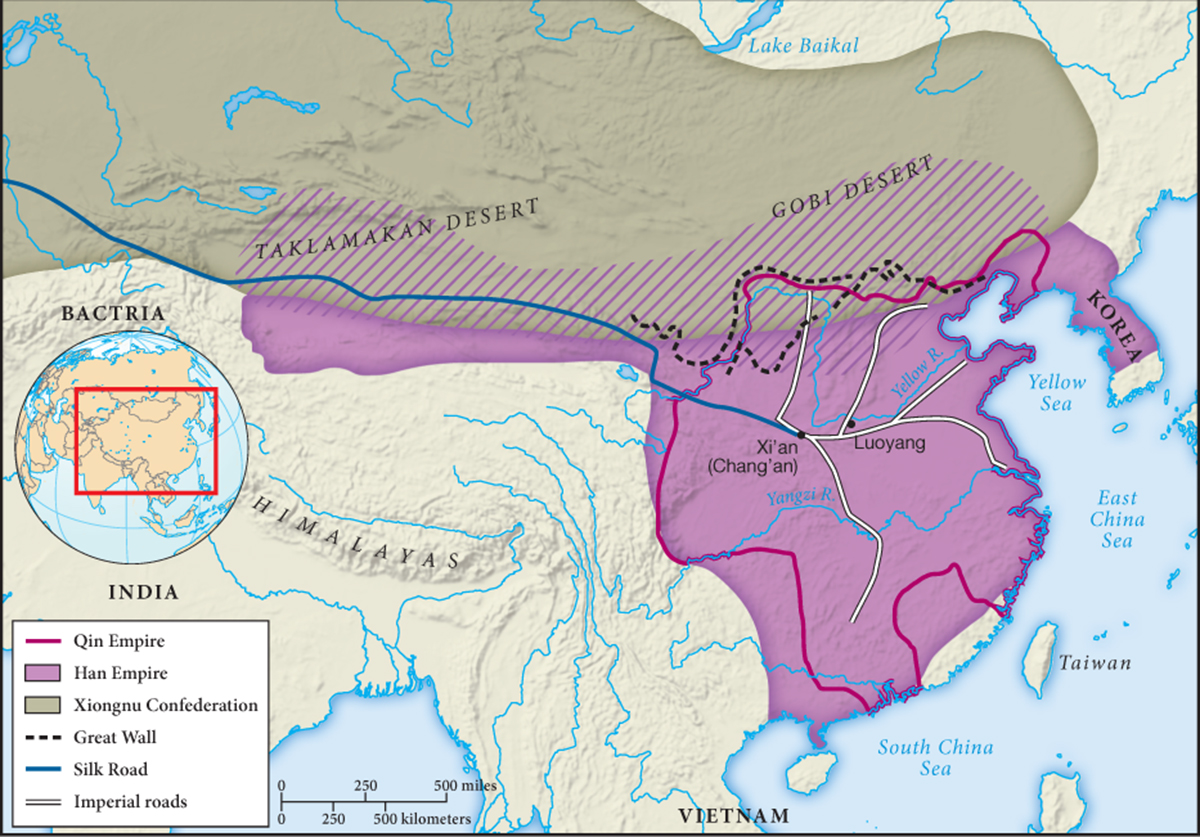China: From Warring States to Empire
About the same time, on the other side of Eurasia, another huge imperial state was in the making—China. Here, however, the task was understood differently. It was not a matter of creating something new, as in the case of the Roman Empire, but of restoring something old. As one of the First Civilizations, a Chinese state had emerged as early as 2200 B.C.E. and under the Xia, Shang, and Zhou dynasties had grown progressively larger. By 500 B.C.E., however, this Chinese state was in shambles. Any earlier unity vanished in an “age of warring states,” featuring the endless rivalries of seven competing kingdoms.
Why was the Chinese empire able to take shape so quickly, while that of the Romans took centuries?
To many Chinese, this was a wholly unnatural and unacceptable condition, and rulers in various states vied to reunify China. One of them, known to history as Qin Shihuangdi (chihn shee-HUANG-dee) (i.e., Shihuangdi from the state of Qin), succeeded brilliantly. The state of Qin had already developed an effective bureaucracy, subordinated its aristocracy, equipped its army with iron weapons, and enjoyed rapidly rising agricultural output and a growing population. It also had adopted a political philosophy called Legalism, which advocated clear rules and harsh punishments as a means of enforcing the authority of the state. With these resources, Shihuangdi (r. 221–210 B.C.E.) launched a military campaign to reunify China and in just ten years soundly defeated the other warring states. Believing that he had created a universal and eternal empire, he grandly named himself Shihuangdi, which means the “first emperor.” Unlike Augustus, he showed little ambivalence about empire. Subsequent conquests extended China’s boundaries far to the south into the northern part of Vietnam, to the northeast into Korea, and to the northwest, where the Chinese pushed back the nomadic pastoral people of the steppes. (See Zooming In: Trung Trac for an example of resistance to Chinese expansion.) Although the boundaries fluctuated over time, Shihuangdi laid the foundations for a unified Chinese state, which has endured, with periodic interruptions, to the present (see Map 3.5).

Map 3.5 Classical China The brief Qin dynasty brought unity to the heartland of Chinese civilization, and the much longer Han dynasty extended its territorial reach south toward Vietnam, east to Korea, and west into Central Asia. To the north lay the military confederacy of the nomadic Xiongnu.
Building on earlier precedents, the Chinese process of empire formation was far more compressed than the centuries-long Roman effort, but it was no less dependent on military force and no less brutal. Scholars who opposed Shihuangdi’s policies were executed and their books burned. Aristocrats who might oppose his centralizing policies were moved physically to the capital. Hundreds of thousands of laborers were recruited to construct the Great Wall of China, designed to keep out northern “barbarians,” and to erect a monumental mausoleum as the emperor’s final resting place. More positively, Shihuangdi imposed a uniform system of weights, measures, and currency and standardized the length of axles for carts and the written form of the Chinese language.
As in Rome, the creation of the Chinese empire had domestic repercussions, but they were brief and superficial compared to Rome’s transition from republic to empire. The speed and brutality of Shihuangdi’s policies ensured that his own Qin dynasty did not last long, and it collapsed unmourned in 206 B.C.E. The Han dynasty that followed (206 B.C.E.–220 C.E.) retained the centralized features of Shihuangdi’s creation, although it moderated the harshness of his policies, adopting a milder and moralistic Confucianism in place of Legalism as the governing philosophy of the state. It was Han dynasty rulers who consolidated China’s imperial state and established the political patterns that lasted into the twentieth century.
